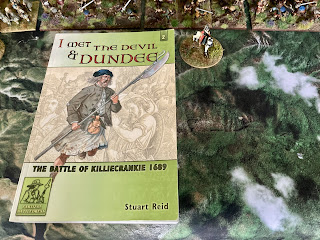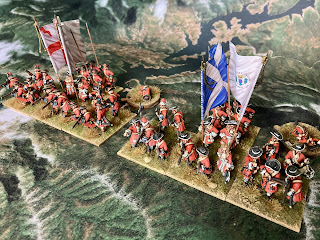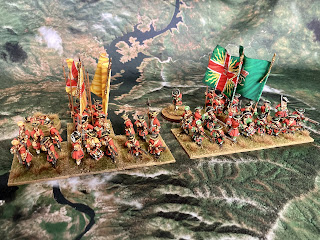Fast forward to Wargames World magazine, issue 3 (it was an occasional Wargames Illustrated publication) and an article on the battle of Killiecrankie, 1689. The article, by Graham Cummings, gave a good description of events, a little bit of information on numbers involved and uniforms and was accompanied by a plan of the battle and photos of Wargames Foundry highlanders battling Dixon Miniatures redcoats with pikes and muskets. It was the sort of article that inspires and you return to just to look at the army dispositions and examine the miniatures in the photos.
Coming back to the now, having absorbed all the information on the Sedgemoor campaign and set Steve Shann off merrily painting the lovely Front Rank minis, I hunted for this old article. Then I bought a few books (“I Met The Devil & Dundee” and “Battle of Killiecrankie 1689. The Last Act of the Killing Times”, both by Stuart Reid, are my favourites). Then I looked for suitable figures!
Now do two small collections make a big collection? I still felt like it was a small collection. The Jacobite army was about 2,000 men and the Scottish government army was about 3,500 strong. I’d not even be doubling my late 17thc collection. It would still be small. I keep telling myself this!
(By way of comparison, Culloden - Drummossie Moor - 16 April 1746, saw something like 14,000 combatants.)
For the bulk of the government army it would be more Front Rank figures as where I need infantry in bonnets, they are there in the range. Easy. For the Jacobites though, especially the highlanders, I didn’t want it to look like a 1745 Jacobite army. So it couldn’t be Front Rank highlanders. Something more primitive was required.
More of that in a mo. First, a summary of this bit in history.
You’ll not have forgotten King James II from the Sedgemoor campaign. The Duke of Monmouth failed to shift him and messily lost his head (the executioner made a right hash of it). James couldn’t be lenient with him. He needed to come down hard on the rebels and show that he was a strong monarch…
He just wasn’t in a strong position though, especially due to his Catholicism, and three years later his Protestant uncle, William of Orange invaded. With a proper army. And a proper navy for that matter. Surely the British army and navy would send the invading Dutch packing? Nope. King James fled to France and the “Glorious Revolution” was an almost bloodless coup d’état. Hello King William III (who married his cousin Mary, as two half Stuarts equal a whole Stuart).
From France James went to Ireland where the army had been purged of Protestants and a bloody civil war followed lasting nearly three years.
James’s champion in Scotland was Viscount Dundee. Often referred to as ‘Bonnie’ Dundee, I’m guessing he was the epitome of the dashing chevalier. He was an officer of the Royal Regiment of Horse after all.
An army began to form around Dundee and the Scottish government dispatched General Hugh Mackay of Scourie to deal with the Jacobites. Having been informed that Dundee was at Blair Atholl castle (I can recommend a visit there when the laird’s private army is mustered), Mackay advanced to bring the Jacobites to battle. The government army needed to go through the pass of Killiecrankie.
The Jacobite army moved out of Blair Atholl and took post on high ground overlooking the track along which the government army would come. And so it did. The government army deployed and there was a small amount of skirmishing.
Come 7 o’clock in the evening it was looking like nothing decisive would happen this day. That’s when Dundee unleashed his highland clansmen down the slope.
Mackay faced heavy criticism afterwards for his deployment: his newly raised militia were in the centre whilst the regular troops, including a single English foot regiment, were on the flanks. Although they suffered terribly from the government musketry, the highlanders punched through and the government army folded.
At some point, Dundee had been shot dead. A remarkable Jacobite victory was effectively nullified. The rest of the short campaign went badly for the Jacobites. Two major engagements followed that saw the Jacobite cause in Scotland crushed within a month of Killiecrankie.
The battle of Killiecrankie, 27 July 1689 is one of those occasions that feeds the myth of the highland charge. In this battle it is likely that their momentum down the slope just kept the clansmen coming on despite terrible casualties.
Back to the figures!
For the Jacobite highlanders I chose the dynamic figures produced by Reiver Castings. They are intended for turn of the 18th century clansmen armed mostly with polearms. So ideal for Killiecrankie.
I got someone other than Steve Shann to paint the highlanders…
As you will see I rescued the situation and the highland regiments are now very presentable.
The Jacobite infantry deployed as per Stuart Reid (they’re the blue army in the illustration). Just without the gaps so I could get them all in shot!
On the extreme left flank are the MacDonalds of Sleat, exact strength unknown. Maybe 500 men. So this regiment is all Reiver Castings and I think they look the part; dynamic and poorly armed! Repainted and based by me.
Where a conventional army had its senior regiments, seniority in highland armies was cycled. Sleat had claimed seniority this day and therefore should have formed the right flank, but due to terrain and lack of experience, the army filed into position from the left.
Next to them stood Sir Alexander Maclean’s regiment. He was a professional soldier and we can expect him to have led a conventionally equipped regiment. His Scottish volunteers were supplemented by Irish regulars. I painted these as Steve has an aversion to tartan! It’s a right mix of Front Rank, Warfare Miniatures and Warlord Games minis.
In all likelihood, they’ll have made heavy weather of coming down the steep slope at Killiecrankie and may have seen none of the fighting. Conventional infantry moved slowly in the late 17thc and much was made of dressing the ranks. If they reached the government lines as a body of foot soldiers rather than a rabble, they’ll have arrived too late to make a difference.
Don’t be surprised to see a conventionally armed regiment in a highland army. 40-ish years earlier the Gordon Strathbogie regiment, with pike and musket, turned out for Montrose, King Charles’ champion in Scotland. (Coincidentally both Dundee and Montrose were called James Graham. No relation?)
Then the dispositions show a large gap between the left and the centre. The first regiment in the centre we get to are the Camerons of Lochiel. There were only 240 men in this regiment and they are believed to have suffered 50% casualties! Just goes to show that even the newly raised government regiment under the Earl of Leven could shoot!
(The government army suffered around 20% casualties, which is probably about right for an army quickly beaten at close quarters and pursued. The casualties may well have been higher had the highlanders not turned to looting the baggage train.)
As you can see I’ve gone for a fairly set look to the clan regiments irrespective of the number of men they represent. Each regiment is three deep bases.
Then we find two more MacDonald regiments;
MacDonald of Glengarry, something like 400-600 strong and given the honour of carrying the Royal Standard.
And the MacDonalds of Clanranald. Only about 200 of these chaps. Good turnout of MacDonalds overall though. Well done that clan!
Completing the Jacobite centre was a regiment of Irish foot.
Colonel James Purcell’s regiment! Probably understrength and like Sir Alexander Maclean’s regiment, they couldn’t possibly have kept up with the clansmen coming down the slope without becoming completely disordered. Front Rank minis painted by Steve Shann.
King James sent meagre forces from Ireland to support Dundee. Many were intercepted as soon as they landed, so that it was only this weakened regiment and a couple of understrength companies with Sir Alexander Maclean that provided some regular foot in the Jacobite army. It may even be the case that these regulars were raw recruits themselves. Some folk have Purcell’s as a dragoon regiment (albeit without horses, so at least on foot) and I can understand that, but I’m of the school of thought that says they were infantry.
With Dundee, behind the centre, were two small troops of cavalry. I can represent these with a single base of figures from my Sedgemoor collection as a ‘tiny’ unit in Black Powder Pike and Shotte terms.
Big gap again and then we get to the final regiment making up the entire right wing.
Sir John Maclean’s clan regiment, 200-300 strong. Bof, there were only two full regiments of experienced Scottish regular infantry facing them! Panic gripped the redcoats before the clansmen reached them…!
The casualty markers to record any tabletop carnage and the command bases to represent Cannon, Dundee and a clan laird. Reiver Castings for Cannon who took command of the Jacobite army following Dundee’s demise. The other command figures are Warfare Miniatures. I painted the righthand base as a tiny amount of tartan was involved: enough to make Steve shudder.
So there you have my miniatures representing the Jacobite army at Killiecrankie.
The Atholl regiment joined the army after Killiecrankie. I managed to hold back enough figures from the other regiments to create this one. Mostly cos I had the flag! All of the lovely flags are from Warfare Miniatures by the way.
Thanks for reading. I hope that you continue to enjoy this series of posts. For the next, I’ll pause the history and miniature parades and describe a play test of Black Powder Pike and Shotte.
Cheers
Chris











































